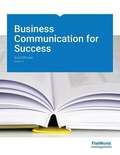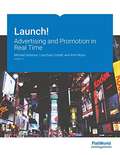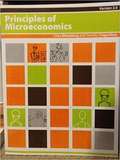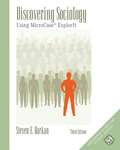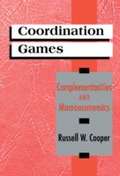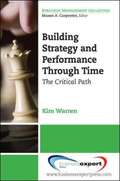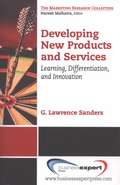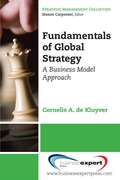- Table View
- List View
Introduction to Economic Analysis
by R. Preston McafeeThis book presents introductory economics ("principles") material using standard mathematical tools, including calculus. It is designed for a relatively sophisticated undergraduate who has not taken a basic university course in economics. It also contains the standard intermediate microeconomics material and some material that ought to be standard but is not. The book can easily serve as an intermediate microeconomics text. The focus of this book is on the conceptual tools and not on fluff. Most microeconomics texts are mostly fluff and the fluff market is exceedingly over-served by $100+ texts. In contrast, this book reflects the approach actually adopted by the majority of economists for understanding economic activity. There are lots of models and equations and no pictures of economists.
Information Systems: A Manager's Guide to Harnessing Technology version 1.2
by John GallaugherInformation Systems: A Manager's Guide to Harnessing Technology V1.2 is intended for use in undergraduate and/or graduate courses in Management Information Systems and Information Technology. Version 1.2 of John's book retains the same structure and theory of version 1.1, but refreshes key statistics, examples, and brings case material up to date (vital when covering firms that move as fast as Facebook, Google, and Netflix). Adopting version 1.2 guarantees your students will have the most current text on the market, drawing real and applicable lessons from material that will keep your class offerings current and accessible.
Economics: Theory Through Applications
by Russell Cooper A. Andrew JohnThis textbook, Economics: Theory Through Applications, centers around student needs and expectations through two premises: ... Students are motivated to study economics if they see that it relates to their own lives. ... Students learn best from an inductive approach, in which they are first confronted with a problem, and then led through the process of solving that problem. Many books claim to present economics in a way that is digestible for students; Russell and Andrew have truly created one from scratch. This textbook will assist you in increasing students' economic literacy both by developing their aptitude for economic thinking and by presenting key insights about economics that every educated individual should know.
Money and Banking
by Robert E. WrightThe financial crisis of 2007-8 has already revolutionized institutions, markets, and regulation. Wright's Money and Banking V 2.0 captures those revolutionary changes and packages them in a way that engages undergraduates enrolled in Money and Banking and Financial Institutions and Markets courses.
International Business
by Mason A. Carpenter Sanjyot P. DunungInternational Business is one of the most challenging and exciting courses to teach in the Business School. To teach a current, dynamic and complete course you need a textbook by authors as passionate and informed about International Business as you are. Carpenter and Dunung's International Business: The Opportunities and Challenges of a Flat World provides exploration into building, leading, and thriving in global organizations in an increasingly flat world. The authors define "Flat world" as one where (1) service industries that dwarf manufacturing industries in terms of scale and scope, (2) an Internet that pervades life and work, and (3) networks define modern businesses, whether service or manufacturing. Carpenter and Dunung's text is designed to speak to technologically-savvy students who see national borders as bridges and not barriers. The authors use the lexicon of international business, and additionally, develop students' knowledge of international contexts with the aim that they may launch, run, and work in any organization that is global in scope (or is wrestling with global competition or other global threats)
Information Systems: A Manager's Guide to Harnessing Technology version 1.3
by John GallaugherInformation Systems: A Manager's Guide to Harnessing Technology V 1.3 is intended for use in undergraduate and/or graduate courses in Management Information Systems and Information Technology. Version 1.3 of John's book retains the same structure and theory of version 1.1 and V 1.2, but refreshes key statistics, examples, and brings case material up to date (vital when covering firms that move as fast as Facebook, Google, and Netflix). For example; the Netflix chapter - Updates address the major changes impacting Netflix in 2011, including the response to the firm's pricing changes, the failed Qwikster service split, recent developments impacting the streaming and DVD-by-mail businesses, a comparison table detailing the stark differences between the firm's two offerings (DVD & streaming), updated statistics, learning objectives, and additional exercises and updates to the Google chapter - Updated text/images for currency, additional sub-sections on the firm's Google+ launch and the acquisition of Motorola Mobility. Adopting version 1.3 guarantees your students will have the most current text on the market, drawing real and applicable lessons from material that will keep your class offerings current and accessible.
Money and Banking v 2.0
by Robert E. WrightThe financial crisis of 2007-8 has already revolutionized institutions, markets, and regulation. Wright's Money and Banking V 2.0 captures those revolutionary changes and packages them in a way that engages undergraduates enrolled in Money and Banking and Financial Institutions and Markets courses. Minimal mathematics, accessible language, and a student-oriented tone ease readers into complex subjects like money, interest rates, banking, asymmetric information, financial crises and regulation, monetary policy, monetary theory, and other standard topics. Numerous short cases, called "Stop and Think" boxes, promote internalization over memorization. Exercise drills ensure basic skills competency where appropriate. Short, snappy sections that begin with a framing question enhance readability and encourage assignment completion. The 2.0 version of this text boasts substantive revisions (additions, deletions, rearrangements) of almost every chapter based on the suggestions of many Money and Banking instructors. Some specific highlights are: Chapter 11 now contains enhanced descriptions of recent regulatory changes, including Dodd-Frank, Chapter 12 is an entirely new chapter on derivatives covering forwards, futures, options, and swaps that also including comprehensive treatment of the causes and consequences of financial crises, and Chapter 14 has updated discussions of the Federal Reserve's monetary policy tools, including paying interest on reserves, and the structure and leadership of the European Central Bank. Recent financial turmoil has increased student interest in the financial system but simultaneously threatens to create false impressions and negative attitudes. This up-to-date text by a dynamic, young author encourages students to critique the financial system without rejecting its many positive attributes. Peruse the book online now to see for yourself if this book fits the needs of your course and students.
Introduction to Economic Analysis
by R. Preston Mcafee Tracy R. LewisThis book presents standard intermediate microeconomics material and some material that, in the authors' view, ought to be standard but is not. Introductory economics material is integrated. Standard mathematical tools, including calculus, are used throughout. The book easily serves as an intermediate microeconomics text, and can be used for a relatively sophisticated undergraduate who has not taken a basic university course in economics. The focus of this book is on the conceptual tools and not on fluff. As such, it reflects the approach actually adopted by the majority of economists for understanding economic activity. There are lots of models and equations, and no pictures of economists ;-) Economic analysis is used in many situations. When British Petroleum sets the price for Alaskan crude oil, it uses an estimated demand model, both for gasoline consumers and also for the refineries to which BP sells. Economic analysis was used by experts in the antitrust suit brought by the U.S. Department of Justice both to understand Microsoft s incentive to foreclose (eliminate from the market) rival Netscape and consumer behavior in the face of alleged foreclosure. Stock market analysts use economic models to forecast the profits of companies to predict the price of their stocks. When the government forecasts the budget deficit or considers a change in environmental regulations, it uses economic models. This book presents the building blocks of the models in common use by an army of economists thousands of times per day. This book, plus econometrics, provides most of the economic analysis tools to take upper division economics courses of any type.
Risk Management for Enterprises and Individuals
by Etti Baranoff Patrick Lee Brockett Yehuda KahaneThis book is intended for the Risk Management and Insurance course where Risk Management is emphasized. When we think of large risks, we often think in terms of natural hazards such as hurricanes, earthquakes or tornados. Perhaps man-made disasters come to mind such as the terrorist attacks in the U.S. on September 11, 2001. Typically we have overlooked financial crises, such as the credit crisis of 2008. However, these types of man-made disasters have the potential to devastate the global marketplace. Losses in multiple trillions of dollars and in much human suffering and insecurity are already being totaled, and the global financial markets are collapsing as never before seen. We can attribute the 2008 collapse to financially risky behavior of a magnitude never before experienced. The 2008 U.S. credit markets were a financial house of cards. A basic lack of risk management (and regulators' inattention or inability to control these overt failures) lay at the heart of the global credit crisis. This crisis started with lack of improperly underwritten mortgages and excessive debt. Companies depend on loans and lines of credit to conduct their routine business. If such credit lines dry up, production slows down and brings the global economy to the brink of deep recession or even depression. The snowballing effect of this failure to manage the risk associated with providing mortgage loans to unqualified home buyers have been profound, indeed. When the mortgages failed because of greater risk- taking on the Street, the entire house of cards collapsed. Probably no other risk-related event has had, and will continue to have, as profound an impact world wide as this risk management failure. How was risk in this situation so badly managed? What could firms and individuals have done to protect themselves? How can government measure such risks (beforehand) to regulate and control them? These and other questions come to mind when we contemplate the consequences of this risk management fiasco. Standard risk management practice would have identified sub-prime mortgages and their bundling into mortgage-backed-securities as high risk. People would have avoided these investments or would have put enough money into reserve to be able to withstand defaults. This did not happen. Accordingly, this book may represent one of the most critical topics of study that the student of the 21st century could ever undertake. Risk management will be a major focal point of business and societal decision making in the 21st century. A separate focused field of study, it draws on core knowledge bases from law, engineering, finance, economics, medicine, psychology, accounting, mathematics, statistics and other fields to create a holistic decision-making framework that is sustainable and value- enhancing. This is the subject of this book.
Business Communication for Success
by Scott McleanThis book is suited for Business Communication courses, but is also appropriate for Business English, Business Presentation, Professional Communication courses. Scott McLean brings his authoring expertise to this new communications textbook. Scott has authored textbooks in the areas of Speech Communication, Interpersonal Communication and Public Speaking. Business Communications for Success benefits from Scott's extensive understanding of how students learn the art of effective communication. Students are provided ample opportunity to engage with the concepts, vocabulary and models covered in the text, including role-playing exercises, journal writings, case studies, small-group activities, games, and self-assessment activities.
Launch! Advertising and Promotion in Real Time
by Michael Solomon Lisa Duke Cornell Amit NizanLaunch! is written for advertising and promotions courses taught to students in the business school and journalism & mass communication students. This book is the first of its kind to teach advertising concepts by reverse engineering a real advertising campaign from beginning to end. In April 2007, SS+K, an innovative New York City communications agency, launched the first ever branding campaign for msnbc.com with the tag "A Fuller Spectrum of News." Launch! follows that campaign from initial agency pitch through roll-out of print and media assets to post-campaign analysis. Throughout, it exposes readers to the theory and concepts of advertising and promotion, and the personalities and decisions that drove this campaign. The book takes a rare look "behind the curtain" - even letting you see some of the paths not chosen by the agency and client. Students get a realistic sense of how theory plays out in practice. They get a flavor for the exciting field of advertising. And, they consistently learn the perspectives of both the advertising agency (where many journalism and communications students will work) and the client (where many marketing majors will work). This is a unique book, with a unique perspective, by a unique author team, and you won't find this kind of insight in any other text on the market.
Principles of Microeconomics 2.0
by Libby Rittenberg Timothy TregarthenFlat World Knowledge is honored to publish Version 2.0 (an orginal re-launch) of Tim Tregarthen's wonderful principles of microeconomics book, and proud to bring Tim's incredible talents as a teacher back to life so future generations of students can continue to learn from him.
Organizational Behavior v 1.1
by Talya Bauer Berrin ErdoganTwo leading researchers in Management, Talya Bauer and Berrin Erdogan, bring you a new Organizational Behavior textbook that bridges the gap between theory and practice with a distinct "experiential" approach. On average, a worker in the USA will change jobs 10 times in 20 years. In order to succeed in this type of career situation, individuals need to be armed with the tools necessary to be life-long learners. To that end, this book is not be about giving students all the answers to every situation they may encounter when they start their first job or as they continue up the career ladder.
Principles of Management
by Mason Carpenter Talya Bauer Berrin ErdoganPrinciples of Management by Carpenter, Bauer and Erdogan teaches management principles to tomorrow's business leaders by weaving three threads through every chapter: strategy, entrepreneurship and active leadership. Strategic: All business school teachings have some orientation toward performance and strategy and are concerned with making choices that lead to high performance. Principles of Management will frame performance using the notion of the triple bottom-line the idea that economic performance allows individuals and organizations to perform positively in social and environmental ways as well. The triple bottom line is financial, social, and environmental performance. It is important for all students to understand the interdependence of these three facets of organizational performance. The Entrepreneurial Manager: While the General Management course at Harvard Business School was historically one of its most popular and impactful courses (pioneered in the 1960s by Joe Bower), recent Harvard MBAs did not see themselves as general managers. This course was relabeled 'The Entrepreneurial Manager' in 2006, and has regained its title as one of the most popular courses. This reflects and underlying and growing trend that students, including the undergraduates this book targets, can see themselves as entrepreneurs and active change agents, but not just as managers. By starting fresh with an entrepreneurial/change management orientation, this text provides an exciting perspective on the art of management that students can relate to. At the same time, this perspective is as relevant to existing for-profit organizations (in the form intrapreneurship) as it is to not-for-profits and new entrepreneurial ventures. Active Leadership: Starting with the opening chapter, Principles of Management show students how leaders and leadership are essential to personal and organizational effectiveness and effective organizational change. Students are increasingly active as leaders at an early age, and are sometimes painfully aware of the leadership failings they see in public and private organizations. It is the leader and leadership that combine the principles of management (the artist's palette, tools, and techniques) to create the art of management. Cases: Mason provides brief cases in his Instructors Manual for those who take a case approach to the course or who wish to incorporate cases. This book's modular format easily maps to a POLC course organization (Planning, Organizing, Leading, and Controlling, attributed to Henri Fayol (1949, General and industrial management. London. Pitman Publishing company), and suits the needs of most undergraduate or graduate course in Principles of Management.
Money and Banking
by Robert E. WrightThe financial crisis of 2007-8 has already revolutionized institutions, markets, and regulation. Wright's Money and Banking V 2.0 captures those revolutionary changes and packages them in a way that engages undergraduates enrolled in Money and Banking and Financial Institutions and Markets courses.
Introduction to Economic Analysis
by R. Preston Mcafee Tracy R. LewisThis book presents standard intermediate microeconomics material and some material that, in the authors' view, ought to be standard but is not. Introductory economics material is integrated. Standard mathematical tools, including calculus, are used throughout. The book easily serves as an intermediate microeconomics text, and can be used for a relatively sophisticated undergraduate who has not taken a basic university course in economics. The focus of this book is on the conceptual tools and not on fluff. As such, it reflects the approach actually adopted by the majority of economists for understanding economic activity. There are lots of models and equations, and no pictures of economists ;-) Economic analysis is used in many situations. When British Petroleum sets the price for Alaskan crude oil, it uses an estimated demand model, both for gasoline consumers and also for the refineries to which BP sells. Economic analysis was used by experts in the antitrust suit brought by the U.S. Department of Justice both to understand Microsoft s incentive to foreclose (eliminate from the market) rival Netscape and consumer behavior in the face of alleged foreclosure. Stock market analysts use economic models to forecast the profits of companies to predict the price of their stocks. When the government forecasts the budget deficit or considers a change in environmental regulations, it uses economic models. This book presents the building blocks of the models in common use by an army of economists thousands of times per day. This book, plus econometrics, provides most of the economic analysis tools to take upper division economics courses of any type.
Personal Finance
by Rachel Siegel Carol YachtPersonal Finance by Rachel Siegel and Carol Yacht is a comprehensive Personal Finance text which includes a wide range of pedagogical aids to keep students engaged and instructors on track. If you would like to hear Rachel talk about her book, and the Personal Finance course listen here to her podcast. This book is arranged by learning objectives. The headings, summaries, reviews, and problems all link together via the learning objectives. This helps instructors to teach what they want, and to assign the problems that correspond to the learning objectives covered in class. Personal Finance includes personal finance planning problems with links to solutions, and personal application exercises, with links to their associated worksheet(s) or spreadsheet(s). In addition, the text boasts a large number of links to videos, podcasts, experts' tips or blogs, and magazine articles to illustrate the practical applications for concepts covered in the text. Finally, the modular nature of the chapters lends itself to the Flat World Knowledge publishing model allowing instructors to adapt the textbook to the exact needs of their specific class and student body.
Principles of Macroeconomics
by Libby Rittenberg Timothy TregarthenFlat World Knowledge is honored to publish a new, first edition re-launch of Tim Tregarthen's wonderful principles of macroeconomics book, and proud to bring Tim's incredible talents as a teacher back to life so future generations of students can continue to learn from him. In 1996, he published the first edition of his principles of microeconomics textbook to great acclaim, and it became widely used in colleges around the country. That same year, MS made him wheelchair-bound. The disease forced his retirement from teaching at the University of Colorado at Colorado Springs in 1998. He lost the use of his arms in 2001 and has been quadriplegic ever since. Tim never let his disease get him down. In fact, he turned back to his love of writing and teaching for inspiration. He obtained a voice-activated computer, recruited a co-author, Libby Rittenberg of Colorado College, and turned his attention to revising his principles of economics book. Today we are excited to introduce Libby Rittenberg and Timothy Tregarthen's Principles of Macroeconomics. The authors teach economics as the study of "choice " by providing students with an accessible, straightforward overview of economics. This text combines the clarity and writing of Tregarthen's seminal periodical "The Margin" with great teaching insights. Rittenberg and Tregarthen help students to understand how real individuals actually work with economics. In this new book, the authors illustrate the practicality and relevance of economics with a variety of new illustrations and insights. The authors take a three-pronged approach to every concept: (1) the concept is covered with a "Heads Up" to ward off confusion, (2) a "You Try It" section makes sure students are staying on top of the concept and (3) a "Case and Point" section that uses a real-world application to harness the concept in reality. For one example of how this plays out in the text see "Chapter 3, Section 2 on Supply".here This book is intended for a one-semester course in Macroeconomics taught out the social sciences or business school.
Sustainability, Innovation, and Entrepreneurship
by Andrea LarsonThis book is suited for the Entrepreneurship or Innovation course with an emphasis on Sustainability or for a course devoted entirely to Sustainability. The deep roots of sustainability thinking are now evident in widespread and increasingly visible activities worldwide, this text will help you and your students explore that necessity, its implications and its progression.
Sociology
by Steven E. BarkanThis best selling software-based workbook lets students explore dozens of sociological topics and issues, using data from the United States and around the world. With the workbook and accompanying ExplorIt software and data sets, students won't just read about what other sociologists have done, they will discover sociology for themselves. DISCOVERING SOCIOLOGY will add an exciting dimension to the introductory sociology course.
Macroeconomics
by Russell Cooper A. Andrew JohnThis book studies the implications of macroeconomic complementarities for aggregate behavior. The presentation is intended to introduce Ph. D. students into this sub-field of macroeconomics and to serve as a reference for more advanced scholars. The initial sections of the book cover the basic framework of complementarities and provide a discussion of the experimental evidence on the outcome of coordination games. The subsequent sections of the book investigate applications of these ideas for macroeconomics. The topics Professor Cooper explores include: economies with production complementarities, search models, imperfectly competitive product markets, models of timing and delay and the role of government in resolving and creating coordination problems.
General Chemistry
by Bruce Averill Patricia EldredgeThe overall goal of the authors with General Chemistry: Principles, Patterns, and Applications was to produce a text that introduces the students to the relevance and excitement of chemistry. Although much of first-year chemistry is taught as a service course, Bruce and Patricia feel there is no reason that the intrinsic excitement and potential of chemistry cannot be the focal point of the text and the course. So, they emphasize the positive aspects of chemistry and its relationship to students' lives, which requires bringing in applications early and often. In addition, the authors feel that many first year chemistry students have an enthusiasm for biologically and medically relevant topics, so they use an integrated approach in their text that includes explicit discussions of biological and environmental applications of chemistry. Topics relevant to materials science are also introduced to meet the more specific needs of engineering students.
Building Strategy and Performance
by Kim WarrenThe fundamental challenge facing business leaders is to drive performance into the future--the dynamics of strategy. To tackle this effectively, they need a clear understanding of what causes performance to improve or deteriorate and what power they have to change this trajectory for the better. Without this understanding, they risk making poor choices about their future--failing to exploit promising opportunities, pursuing unachievable aims, or falling victim to competitive and other threats. Building Strategy and Performance Through Time sets the agenda for building business strategy in powerful, actionable, and accessible terms. It gives executives clear frameworks for answering three fundamental questions: * Why is our business performance following its current path? * Where is it going if we carry on as we are? * How can we design a robust strategy to transform this future? The existing strategy tools most widely used help guide management's choices about where to compete--which customers to serve, with what products and services, and how to deliver those products and services to those customers effectively and profitably. While this choice is important, it is not often changed in any fundamental way; having found a reasonably strong and profitable position on these issues, few firms will, or should, set off in a new direction. But there is still much to be done to deliver that strategy, powerfully and sustainably over time. Many decisions need to be made, continually and holistically, across all functions of the business and adapted as conditions change from month to month and year to year. Pricing, product development, marketing, hiring, service levels, and other decisions cannot be made in isolation but must take into account other choices being made, elsewhere and at different times. Building Strategy and Performance Through Time explains a reliable, practical method, known as strategy dynamics, that creates a living picture of how an enterprise actually works and delivers performance. This picture shows exactly where the levers are that management controls and how to choose what to do, when, and how much, to accomplish your specific goals. It shows, too, how the same approach can be used to defeat competitors, cope with other outside forces, and keep delivering performance.
Developing New Products and Services
by G. Lawrence SandersThe focus of the book is on the up-front activities and ideas for new product and service development. A central theme of this book is that there is, or should be, a constant struggle going on in every organization, business, and system between delivering feature-rich versions of products and services using extravagant engineering and delivering low-cost versions of products and services using frugal engineering. Delivering innovative products is accomplished by an endless cycle of business planning, creative and innovative insight, and learning-about and learning-by-doing activities. A number of powerful concepts and tools are presented in the book to facilitate new product development. For example, three templates are presented that facilitate new product and service development. The FAD (features, attributes, and design) template is used to identify the features and attributes that can be used for product and service differentiation. The Ten-Ten planning process contains two templates: an Organizational and Industry Analysis template and the Business Plan Overview template. These two templates coupled with the FAD template can be used to develop a full-blown business plan. Entrepreneurship, technology and product life cycles, product and service versioning, product line optimization, creativity, lock-in real options, business valuation, and project management topics are also covered.
Fundamentals of Global Strategy
by Cornelis A. de KluyverThis book looks at the opportunities and risks associated with staking out a global competitive presence and introduces the fundamentals of global strategic thinking. We define crafting a global strategy in terms of change: how a company should change and adapt its core (domestic) business model to achieve a competitive advantage as it expands globally. The conceptual framework behind this definition has three fundamental building blocks: a company's core business model, the various strategic decisions a company needs to make as it globalizes its operations, and a range of globalization strategies for creating a global competitive advantage. A business model is defined in terms of four principal components: (a) market participation--who its customers are, how it reaches them and relates to them; (b) the value proposition--what a company offers its customers; (c) the supply chain infrastructure--with what resources, activities and partners it creates its offerings; and finally, (d) its management model--how it organizes and coordinates its operations. Globalization requires a company to make strategic decisions about each component of the business model. Market participation decisions include choosing which specific markets or segments to serve, domestically or abroad; what methods of distribution to use to reach target customers; and how to promote and advertise the value proposition. Globalization decisions about the value proposition touch the full range of tangible and intangible benefits a company provides to its customers (stakeholders). Decisions about a company's value chain infrastructure deal with such questions as, What key internal resources and capabilities has the company created to support the chosen value proposition and target markets? What partner network has it assembled to support the business model? How are these activities organized into an overall, coherent value creation and delivery model? Finally, strategic decisions about the global management dimension are concerned with a company's choices about a suitable global organizational structure and decision-making process. We use Pankaj Ghemawat's well-known "AAA Triangle" framework to define three generic approaches to global value creation. Adaptation strategies seek to increase revenues and market share by tailoring one or more components of a company's business model to suit local requirements or preferences. Aggregation strategies focus on achieving economies of scale or scope by creating regional or global efficiencies; they typically involve standardizing a significant portion of the value proposition and grouping together development and production processes. Arbitrage is about exploiting economic or other differences between national or regional markets, usually by locating separate parts of the supply chain in different places.


